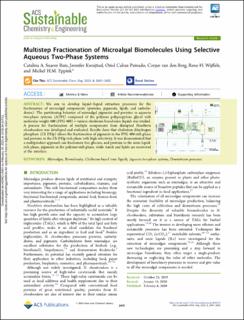| dc.contributor.author | Ruiz, Catalina A. Suarez | |
| dc.contributor.author | Kwaijtaal, Jennifer | |
| dc.contributor.author | Peinado, Oriol Cabau | |
| dc.contributor.author | van den Berg, Corjan | |
| dc.contributor.author | Wijffels, Rene Hubertus | |
| dc.contributor.author | Eppink, Michel H.M. | |
| dc.date.accessioned | 2021-03-01T09:32:54Z | |
| dc.date.available | 2021-03-01T09:32:54Z | |
| dc.date.created | 2021-02-18T14:23:22Z | |
| dc.date.issued | 2020 | |
| dc.identifier.citation | Ruiz, C. A. S., Kwaijtaal, J., Peinado, O. C., van den Berg, C., Wijffels, R. H. & Eppink, M. H. M. (2020). Multistep fractionation of microalgal biomolecules using selective aqueous two-phase systems. ACS Sustainable Chemistry and Engineering, 8(6), 2441-2452. doi: | en_US |
| dc.identifier.issn | 2168-0485 | |
| dc.identifier.uri | https://hdl.handle.net/11250/2730843 | |
| dc.description.abstract | We aim to develop liquid–liquid extraction processes for the fractionation of microalgal components (proteins, pigments, lipids, and carbohydrates). The partitioning behavior of microalgal pigments and proteins in aqueous two-phase systems (ATPS) composed of the polymer polypropylene glycol with molecular weight 400 (PPG 400) + various cholinium based-ionic liquids was studied. A process for fractionation of multiple components from disrupted Neochloris oleoabundans was developed and evaluated. Results show that cholinium dihydrogen phosphate (Ch DHp) allows the fractionation of pigments in the PPG 400-rich phase and proteins in the Ch DHp-rich phase with high selectivity. It was demonstrated that a multiproduct approach can fractionate free glucose, and proteins in the ionic liquid-rich phase, pigments in the polymer-rich phase, while starch and lipids are recovered at the interface. | en_US |
| dc.language.iso | eng | en_US |
| dc.publisher | American Chemical Society | en_US |
| dc.rights | Attribution-NonCommercial-NoDerivatives 4.0 Internasjonal | * |
| dc.rights.uri | http://creativecommons.org/licenses/by-nc-nd/4.0/deed.no | * |
| dc.title | Multistep fractionation of microalgal biomolecules using selective aqueous two-phase systems | en_US |
| dc.type | Peer reviewed | en_US |
| dc.type | Journal article | en_US |
| dc.description.version | publishedVersion | en_US |
| dc.rights.holder | © 2020 American Chemical Society | en_US |
| dc.subject.nsi | VDP::Matematikk og Naturvitenskap: 400::Basale biofag: 470::Molekylærbiologi: 473 | en_US |
| dc.subject.nsi | VDP::Matematikk og Naturvitenskap: 400::Basale biofag: 470::Biokjemi: 476 | en_US |
| dc.subject.nsi | VDP::Teknologi: 500::Bioteknologi: 590 | en_US |
| dc.source.pagenumber | 2441-2452 | en_US |
| dc.source.volume | 8 | en_US |
| dc.source.journal | ACS Sustainable Chemistry and Engineering | en_US |
| dc.source.issue | 6 | en_US |
| dc.identifier.doi | 10.1021/acssuschemeng.9b06379 | |
| dc.identifier.cristin | 1891407 | |
| dc.description.localcode | Paid Open Access | en_US |

